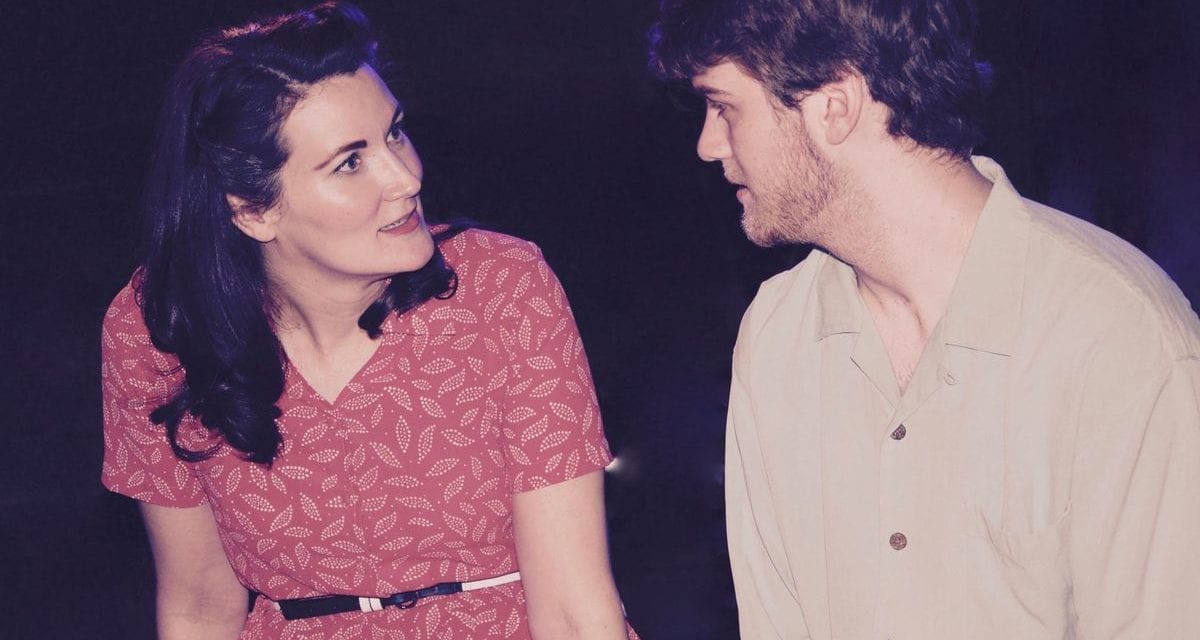PROVO — “You never know what will happen on a train.”

Show closes March 11, 2017.
This one line, from Arlene Hutton’s script, perfectly summarizes Last Train to Nibroc, an enjoyable production currently playing at the Covey Center for the Arts. This quiet little play about the romance between its two characters is a gem of a show that deserves the attention of Utah audiences.
Last Train to Nibroc begins in the midst of World War II when two strangers, May (played by Kynsie Kiggins) and Raleigh (played by McKay Nicoll) meet by chance on a westbound train from Los Angeles. Both find that they are from nearby hometowns and that they have been disappointed by their experiences that have put them on their shared train. Raleigh has been discharged from the armed forces for medical reasons, while May is reeling from a broken off engagement. Over the course of the play a friendship develops that blossoms into a romance.
What makes Last Train to Nibroc work is the careful direction from D. Terry Petrie. With just two characters in the play, Last Train to Nibroc has the danger of becoming an extended two-person acting class exercise. However, Petrie avoided this by helping his cast cultivate authentic human relationships that made the characters seem completely real. I especially enjoyed how Petrie emphasized the shifts in power between the two characters, such as when Raleigh exposes May’s ignorance about literature or her own hometown. Another strength of the director was how he allowed the quiet moments (such as when May says that her preacher boyfriend asked her to leave town with him) to land so that the audience could mull over new plot developments.

Kynsie Kiggins as May and McKay Nicoll as Raleigh.
Kiggins and Nicoll were successful in creating two vulnerable people who were scared of being hurt again. Kiggins gave May a guarded nervousness that gradually turned into a calm familiarity with Raleigh over the course of the play. Nicoll, on the other hand, had a twinkle in his eye and gave Raleigh a touch of dreamy ambition. Together, the two characters developed a subtle sexual tension that served as a powerful engine for the play’s action. More importantly, May and Raleigh were people that I enjoyed spending my evening with—a fact that is hugely important in a play that consists solely of two characters’ conversations.
But this description doesn’t do justice to Hutton’s script. Although the play is a romance, it avoids all the clichés of romantic comedies. Indeed, the dialogue is so naturalistic that I often felt like I was eavesdropping on Raleigh and May’s conversations. (The small Brinton black box at the Covey Center surely contributed to this intimate feeling.) Hutton is especially good at foreshadowing without making future events obvious. Therefore, as the action between the two characters unfolded, the outcomes seemed like a natural progression of earlier events.
Although Last Train to Nibroc deserves a wide audience, there are a few minor snags that keep this production from perfection. The most annoying one was Nicoll’s 21st century hair, which was impossible to ignore in the small space and when accompanied by Nancy Cannon’s perfect 1940’s period costumes. Additionally, the blocking occasionally felt forced; I understand that Petrie sometimes needed to provide some visual variety to the scenes, but when the actors would wander around during the train scene, it made me question the geography of the train car and whether it was as crowded as the characters said. These, however, are trivialities; this play is a character-driven piece and what matters far more is how the audience can get to know May and Raleigh—and nothing can stand in the way of that.
Last Train to Nibroc is a show that relies on its carefully crafted script, requires deft directing, and needs two talented actors who are capable of creating real, three-dimensional characters on stage. If any of these important components were subpar, Last Train to Nibroc would derail and become a theatrical train wreck. Instead, the Covey Center’s production is a rich study of two individuals’ psychology with a touch of sweetness that makes the performances a pleasant night at the theatre. Although this is not the flashiest play available to Utah audiences right now, I recommend that readers hop aboard the Last Train to Nibroc because, “You never know what will happen on a train.”






